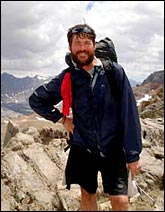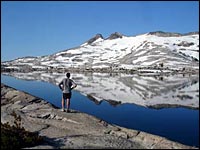
David Nova.
While camping alone in the Mojave Desert three years ago, David Nova was suddenly struck by the lack of human influence — no buildings, no streetlights, no cars, all the way to the horizon. It wasn’t the first time the avid hiker had thought about the effects of population on the environment, but it was the moment he decided he could do something about it.
A longtime social activist who is president and CEO of a western Virginia Planned Parenthood network, Nova began making plans to hike the 2,650-mile Pacific Crest Trail. The journey would not only fulfill a 20-year-old dream (he’d bought guidebooks for the trail in 1986, shortly after completing a thru-hike of the Appalachian Trail), it would also raise awareness about population and consumption in the U.S.
Nova set out on the five-month trek, dubbed PopHike, in April. With the help of supporters and Planned Parenthood contacts, he raised $100,000 for organizations working on population issues and, he says, inspired at least a few people to change their lifestyles.
After meeting him in Seattle just one day off the trail, Grist caught up with Nova again once he’d had time to catch his breath. We talked with him about the physically demanding hike, the changes he’s made in his own life since coming home, and the trappings of our consumption-driven society.
What inspired you to make your PopHike trek?
PopHike was my attempt to raise awareness of the 1994 U.N. Cairo Agreement during a five-month thru-hike of the Pacific Crest Trail. The PCT runs from Mexico to Canada; it’s the West Coast equivalent of the Appalachian Trail. For years I’ve seen the encroachment of residential and commercial developments threaten to reduce the AT from a wilderness trail to some sort of long, suburban park. I wanted to find a way to use my thru-hike to raise concerns about the effects of population on both the AT and the PCT.

A reflective moment on the trail.
Could you explain the theme for your hike, “From Mexico to Canada by way of ‘Cairo'”?
Cairo is a non-binding agreement developed in Egypt in 1994. Under Cairo, the nations of the world threw out the paternalistic notion of “population control.” They recognized that empowering women is a more effective approach to global sustainability. By providing women with education, free health care, and job opportunities, impoverished nations become increasingly developed and women begin to see themselves as more than mere vehicles for procreation. The result is a natural reduction in family size and population growth. The Cairo Agreement also calls upon developed nations like the United States to limit the overconsumption of our natural resources.
PopHike is my way of drawing funding and attention to this practical and innovative agreement. Most people have never heard of the Cairo Agreement. Though the Clinton administration embraced it, the Bush administration now largely ignores it. That’s got to stop.
What was your experience like?
The Pacific Crest Trail is amazing. It begins in the desert along the Mexican border. It passes through the high mountains of the Sierra Nevada and then along the spine of the Cascade Mountains through central Oregon and Washington, reaching elevations of up to 13,000 feet. During my trek, temperatures varied from under 20 degrees Fahrenheit to a high of 111. This year’s hike was especially challenging due to the enormous snowpack in California. I walked with snow on the trail most days from April through the end of July. Three out of four thru-hikers failed to finish this year, and snow was the primary factor. Several hikers even died along the route due to snow-related accidents.
Hiking this trail was the hardest thing I’ve ever done. But after a few months, I developed a real sense of connection with the wilderness. I knew I was outdoors, but I no longer felt like I was outside. And the dirt just didn’t seem that dirty anymore. Instead of using my tarp, I began sleeping out under the stars. I gained a sense of intimacy with the natural world that simply cannot be achieved during a weeklong backpacking trip. I also began to relish the solitude and isolation.
How did you reduce the amount of weight you carried?
I did everything I could think of. I hiked in sneakers rather than boots. Instead of a three-pound tent, I made an 11-ounce tarp. Rather than a commercial backpacking stove, I used a two-ounce stove made with recycled cat-food cans. I cut the lining out of my nylon shorts and the handle off my toothbrush. I even made my own crampons using machine screws and hex nuts. I also became very miserly — carefully measuring out just enough fuel for cooking and using toilet paper by the sheet.
When thru-hiking, you don’t buy what you can afford — you buy only what you can afford to carry. As a result, thru-hikers become very conscientious consumers. If everyone had to carry all their possessions on their backs, there would be no worries of overconsumption.

Clear-cuts along the northern half of the PCT.
Did you see any evidence of climate change or other environmental problems on the trail?
Though many of the glaciers along the Pacific Crest Trail are apparently receding, loss of habitat seemed to me the most pressing environmental concern. The expansion of housing developments in Southern California is depressingly obvious. In Oregon and Washington, it’s the clear-cut forests that seem to have the greatest environmental toll on habitat.
Has your daily life changed since you’ve returned? Do you consume less?
I’ve recognized that so many of my insights during the hike are not compatible with my usual routine. I am still grappling with how I need to change, but I feel change is inevitable. I have made about a dozen trips to the local Goodwill to drop off all sorts of furniture, housewares, and appliances that I no longer want. I think I used to judge my worth by my possessions; now those possessions seem more like clutter. I have also decided to walk to work once a month. It’s 13 miles roundtrip. Hopefully, I can inspire others to leave their cars at home once in a while.
Would you say PopHike was a success?
The website presence, media interviews, speaking engagements, and events all combined to generate awareness of the Cairo Agreement. PopHike also raised about $100,000 in donations and per-mile pledges for organizations that support the tenets of PopHike. I even think I inspired a few people to make permanent changes to their lifestyles.
Yet even when I was out there, my efforts sometimes felt like a drop in the bucket. Now I see all the holiday marketing efforts urging us to consume more. I don’t know how to compete with that.

Solitude in the high desert.
How do you see your work with Planned Parenthood meshing with the goals of the environmental movement?
Environmentalism is already implicit to Planned Parenthood’s agenda — I think it should be more explicit. Planned Parenthood has had a huge environmental and human-rights impact in developing nations that lack access to affordable contraceptives and sexuality education.
Planned Parenthood now needs to consciously seek ways to have a greater environmental impact in the U.S. We have 900 health centers nationwide serving millions of women, couples, and teens. I can see many ways in which our waiting rooms could serve as locations to promote environmental health as well as reproductive health.
Among environmentalists, the topic of population is often controversial, but the related topic of consumption is readily accepted as a problem. How should we be talking about the connections between the two, and possible solutions?
I see the concepts of “overpopulation” and “population control” as outdated and paternalistic. The Cairo Agreement moves beyond such notions. Cairo considers how best to improve the quality of our lives and of the natural world, given both our population trends and our excesses in consumption. It’s not a series of laws or impositions, but rather a collective handshake among the nations of the world. Cairo recognizes that the solution is empowerment rather than control. I think that’s something environmentalists everywhere can agree to support.
The future of developing countries is often part of the population dialogue, especially in terms of consumption and environmental health. How can we address these issues in countries where people are just reaching the point where they can afford to consume more and don’t want to give that up?
It’s a great question, and one I grappled with for 2,000-plus miles. The populations of India and China are replacing their bicycles with cars and their huts with homes. These improvements in living standards are to be celebrated. However, such changes place an even greater burden on our dwindling natural resources. I don’t have a solution for this trend. Organizations like the Center for a New American Dream are seeking solutions by encouraging conscientious consumption on a voluntary basis.
In the end, most people won’t choose moderation unless they have to. We may all be forced to conserve as our natural resources become scarce and, consequently, more expensive. I hope we never reach that point. A better solution has to come soon if we are to sustain our environment and improve the quality of our lives.


